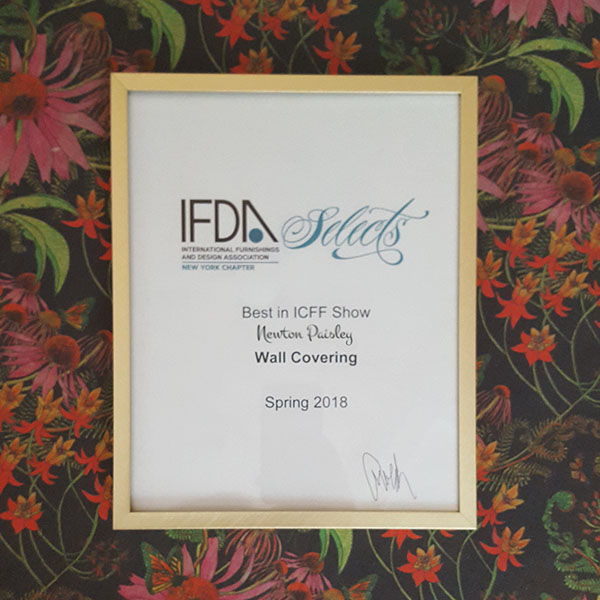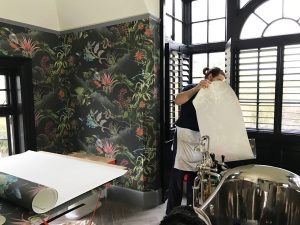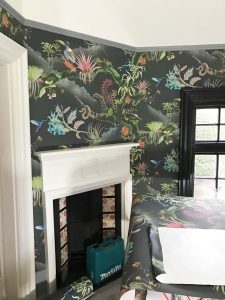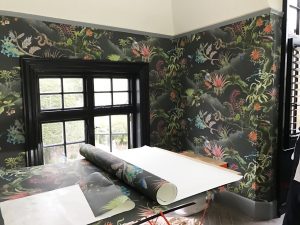I just returned from a fantastic visit to High Point, North Carolina to their Fall Market, famous as being the largest home furnishings market in the world. Something in the range of 75,000 people come to this small town where around 2000 exhibitors do their best to sell their wares. It was particularly special for me to make it to High Point because this is the home town of Anne Newton Paisley, my late mother, after whom the business was named. I gave a talk on ‘Biodiversity, Pattern and Design’ which can be seen below, hosted by Zoe Bios Creative and the Sustainable Furnishings Council.
Introducing Paisley Paramecium
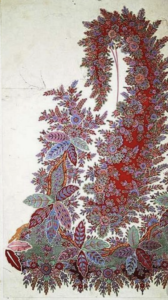
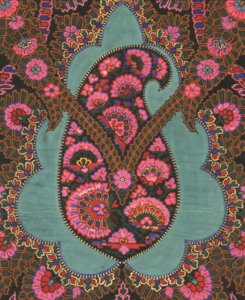
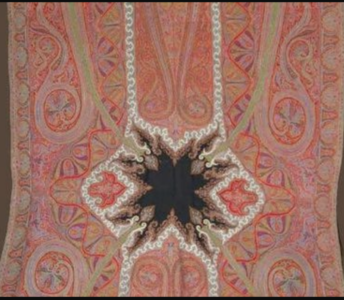
My last name is Paisley. I know - kind of hilarious for a textile designer. Apparently this sort of seeming coincidence is referred to as Nominitive Determinism, and there are countless examples. One of my favourite examples is Dr Dick Chopp, the Texan urologist who is known for performing vasectomies. Anyway, I’ve always felt quite connected to the swirly world of the paisley pattern, from psychedelic Pucci of the 1970s to its ancient structured Persian ancestors and everything in between.
By the way, there is a great exhibition on at the Cooper Hewitt Design Museum in New York City called Design by Nature which has a fascinating section on the paisley motif - the introduction to which can be seen here. Anyway, five years ago when I was making my first foray into the design world, I met someone who learned I was a textile-mad biologist and said I should “be called Susy Paramecium not Susy Paisley” (a paramecium, in case you haven’t met one, is a tear-drop shaped microorganism). The idea for a paisley design based on real microorganisms popped into my head and I have been gently thinking about it ever since..
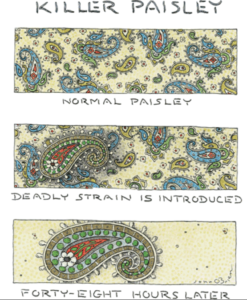
It has been a surprise to find myself falling in love with the tiniest creatures in Earth, having always studied big beasties like bears. I've been learning about organisms so small that millions can fit in a drop of water, and billions in a gram of soil. Microbes inhabit the widest range of habitats from sub-freezing temperatures, to water hotter than boiling, from lava, to the atmosphere miles above Earth, to glaciated mountain peaks and to the deepest ocean trenches. They include the strongest animals on Earth, the biggest producers of oxygen and greatest storers of carbon.
I wanted the design to evoke droplets of water as well as using the conventions of the paisley design. I also intended it to be reminiscent of stitching and lace, as the fabric of nature is fragile and intricately interwoven and embellished. I could exercise a bit of freedom in the colouration, and can further expand on this in the future, as many of these species are really quite transparent.
The species in my design are all aquatic - living in both fresh and sea water. They include many species of free-floating plankton, both zooplankton (more like animals) and phytoplankton (which are more like plants). Phytoplankton form the base of the marine food web. The health of all marine creatures, from fish fry to whales, is dependant the health of phytoplankton. They are also of serious conservation concern: warming oceans have caused levels of phytoplankton to decline 40% since 1950.
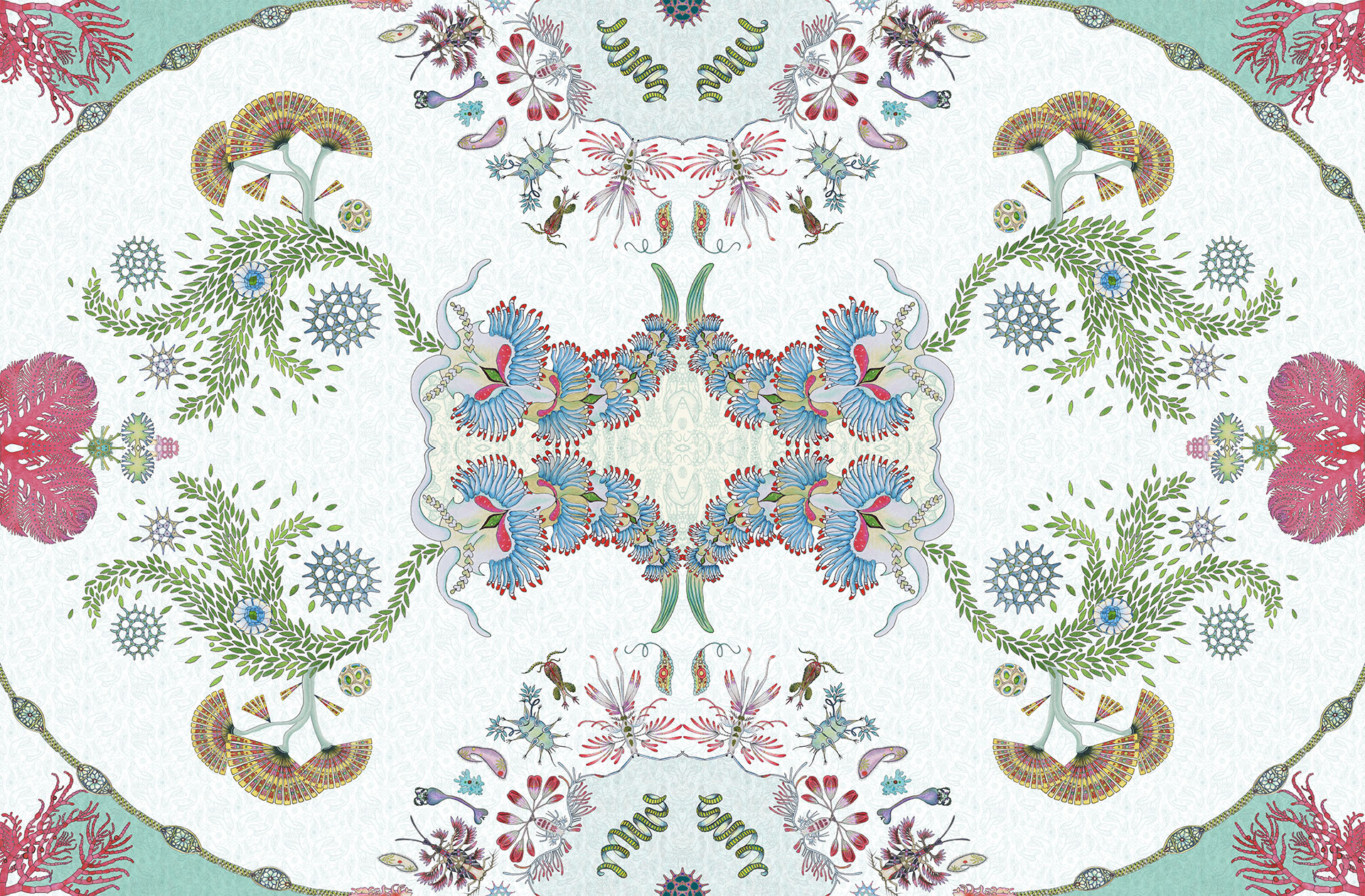
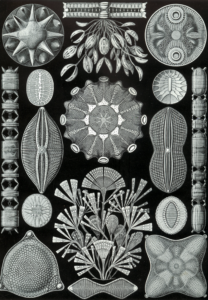
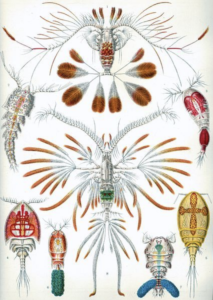
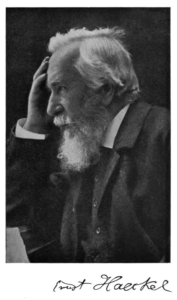
In my design, the swirls of what look like rice or tiny leaves are Euglena gracilis. It was the question of how to classify these particular "unclassifiable" beings with features of both plant and animals, that prompted early taxonomists like Ernst Haeckel to add a third living kingdom to Plantae and Animalia: the Kingdom Protista. Actually it was Ernst Haeckel’s stunning illustrations of copepods, diatoms, and nudibranchs that brought the beauty of these creatures to public awareness. (One of the colourways of this design is named after him.)
In with the Euglena are circular organisms: Prochlorococcus, a type of phytoplankton that releases countless tons of oxygen into the atmosphere. In fact they are the most abundant photosynthetic organisms on the planet. Some scientists estimate that Prochlorococcus provides the oxygen for one in every five breaths we take. The design also includes the extraordinary forms of several species of diatoms, looking like cogs, spirals (Chaetoceros debilis) and fans (Licomopha flagellata) and other ornamented spheres (various cocolithosphores). The two pink forms are marine algae (Ptilota and Pterothamnion plumula). The long chains are marine algae: fragments of Spirogyra and a colonial diatom called Helicotheca.
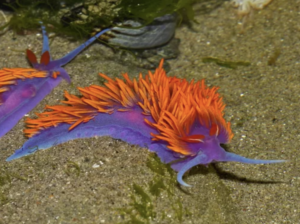
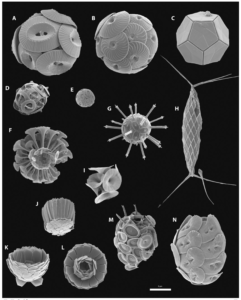
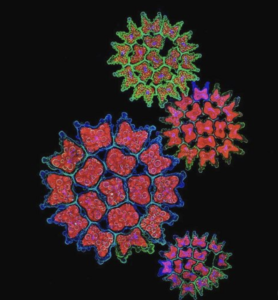
The largest organisms in my design, yet still only a couple of centimetres in length, are aeolid nudibranchs. Facelina auriculata, was discovered by Müller in 1776, the year of American independence. These little beauties are very variable in colour with poetic common names like 'clown', 'splendid', 'dancer', and 'dragon'. Because their colouring is so variable, and in honour of 1776 and the American Independence, I whipped out my artistic license, and made my nudibranchs largely Red, White and Blue.
Around the centrals circles are unicellular paramecia (the paisley-shaped creatures), and amoebas. Also a water bear - a tardigrade. The rest of the creatures around that central circle are copepods - a group which, combined, forms the largest biomass on the Earth. And they are freakishly strong. Relative to their size, typically about 1mm long, copepods are also the world’s fastest animal, being able to jump at a rate of about a half a meter per second. Their incredible strength, relative to their size, makes them more than ten times stronger than any other known species on the planet and even stronger than any human-made motor produced to date.
They don’t only qualify as superheroes for their strength and speed. It is estimated that copepods absorb 1-2 billion tons of carbon per year. This makes them the largest carbon sink in the world, handily transporting massive amounts of carbon to the deep sea.
The whole living world relies on these beings, only 1% of which have been identified never mind appreciated. So this is my paisley tribute to these intriguing mini-miracles - so symmetrical and precise in form and yet totally bizarre - that are literally everywhere and yet invisible to the naked eye. Enjoy! Let me know what you think...
Newton Paisley is British and also passionately European
When I started Newton Paisley in September 2016 I was really excited about ‘Made in Britain’. Doing all of the printing and the weaving for my products here in the UK felt like just the right thing to do. I was concerned about sustainability, loved buying local and I had visited fabric shops all over Europe where nearly all of the fabric they had was made in China. I knew that the proud traditions of textile manufacture had been nearly wiped out by the systematic poaching of technology and experts and the ability to undercut in price – I wanted to do what I could to push against that.
But as I learned more about linen, the more I realised that “local”, at least to me in Kent, England, actually crossed national borders…
Newton Paisley is based in Whitstable in Kent. In 2 hours we can be in London, or we can be in northern France or Belgium. Early in my explorations of setting up this business, I began learning about linen, a textile I had always loved. I discovered that though it only makes up 1% of the global textile market, 85% of the world’s fine linen comes from Europe. I realised across the Channel from me was the real linen heartland, a unique band of coastal land, stretching from southern Normandy through Belgium around to Amsterdam, with the perfect cool damp climate and ideal soils to grow the finest flax in the world.
I sketched out a map to show you the basic local geography of my business these days. I also make wallpaper (printed in the UK), but on the printed linen side, production reaches across the Channel. The flax, the plant from which linen is made, is grown in the green band, that “linen heartland”, where it is then harvested, retted, scutched, and combed. Learn more from the excellent website of the The European Confederation of Flax and Hemp (CELC). Then the fibres are spun into thread in Europe (often in Italy) and then woven into the cloth I print on, in several independent mills in France, Belgium, Scotland and Northern England. My printing and finishing is all done in the UK.
As you can see, several essential stages of this process are closer to me across the Channel than in the UK.
(By the way, it is true that flax can be grown in the UK though it is a very minor crop here. Lovely Francesca Baur is doing a lovely project called Kent Cloth in which she is encouraging people to grow and dye and work with linen here.)
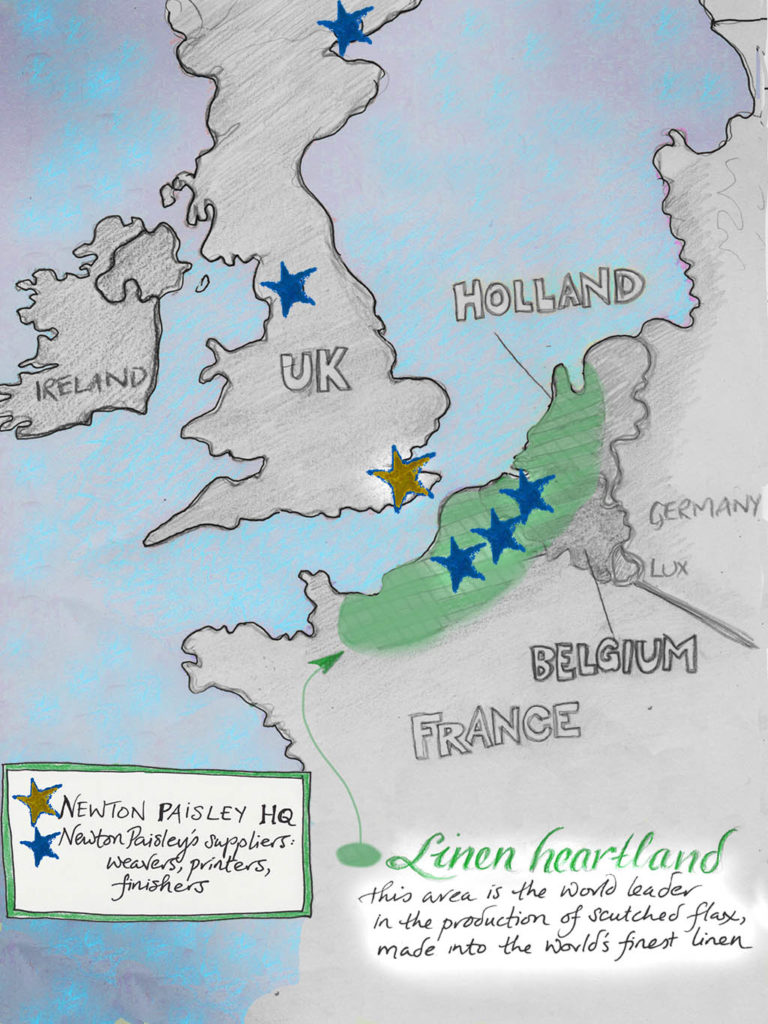
Four years ago, when starting Newton Paisley was just a tender bud of an idea, I took a train to Lille and went to visit Lemaitre Demeestere, founded in 1835. It is one of the oldest extant textile companies in France and the only one to work exclusively with flax fibres that are entirely processed in Europe. Olivier Ducatillion is the owner and was an extremely charming host to me with his excellent English before I spoke any French. This lovely very short (90 second) film I found was made in their factory. Turn up the sound.
I had never seen industrial production before and wasn’t at all prepared for how beautiful and moving it was. Every person and every machine working finely in tune with each other. There was even a cat, equally committed to his essential mousing patrols. Olivier is passionate about the natural environment and showed me his own personal experiments in the natural dying of his linens. It was in summer and the train back travelled through farmland growing flax with its beautiful blue flowers… sigh…
It isn’t an exaggeration to say that day really changed my life. I decided I had to work with this noble, natural, ancient product and print my designs on it all about the wild species I love. The tender bud of an idea for Newton Paisley sprouted leaves and flowers that day in northern France.
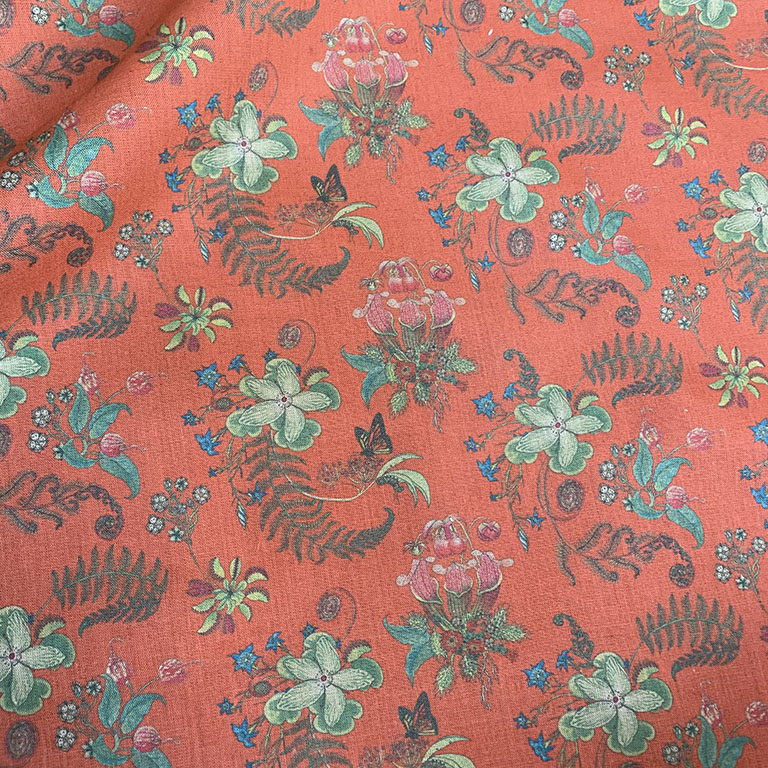
A Newton Paisley pattern called Carolina Posies printed on medium weight linen
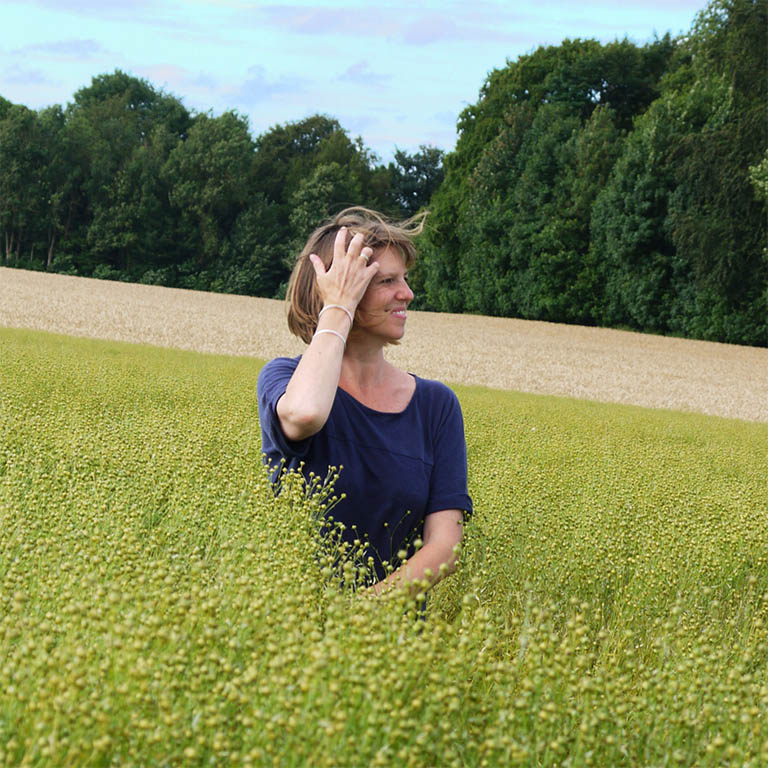
Susy Paisley in a field of flax in northern France
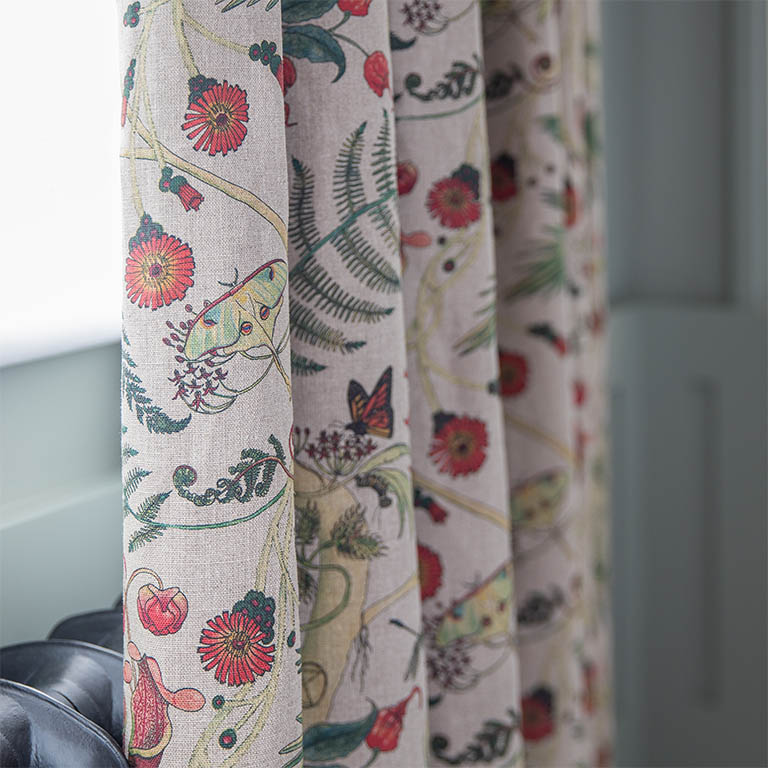
A Newton Paisley pattern called Carolina Parakeets printed on heavy weight linen
One day soon I will write more about the environmental benefits of this fibre and its incredible European cultural heritage. But today is March 29, 2019, the day the UK was scheduled to be leaving the European Union. Today I mainly wanted to say how much being European means to me personally and to this business.
Newton Paisley benefits greatly from the working relationships we have with our local French and Belgian suppliers and European clients. This whole industry depends completely on European collaboration. At this moment of advancing nationalism, protectionism and isolationism, I just wanted to set down in words how important close ties with Europe are to me and my small independent business. For me, caring as I do about issues like nature conservation, world peace, and human rights (and also being a linen nerd), European unity means the world.
By the way, if you want to geek out on linen, this is another lovely film. If you’ve never seen it, it’s a joy. It is 15 mins long but really worth watching.
BBC Designed

Thank you very much to Liza Foreman and BBC Designed for this lovely write-up. Also to David Oxberry for the portraits of me in my studio.
http://www.bbc.com/culture/story/20180301-the-designer-celebrating-rare-and-endangered-species

Launching Our Wallpaper
When we launched our fabrics at Decorex last year, and consistently ever since, people have asked if we would be producing the designs as wallpaper. Textiles, especially linens, are my first love, and it took me a while to come around to the idea, but I am now officially a complete convert. The layered effect in a room, how it enlarges and deepens the space, the clarity of the printing and the colour…it’s addictive!
So it is with joy that we are able to launch all of our fabric designs as wallpaper. After sampling with many manufacturers, we are delighted with the product that we have achieved: a fine gicleé digitally-printed “real” wallpaper. We are printing in the UK on a natural non-woven cellulose-based substrate made from recycled materials – recycled polyester (PET) fibre and recycled wood pulp. The production process is solvent free with minimal waste and energy inputs. The papers are fire certified for Europe and North America, and can be sponge wiped. I am also besotted with the mellow, vibrant colours. We are looking forward to sharing it widely, so do request any samples that interest you.
We are in the process of updating all of the designs on the website to reflect their availability as wallpaper. In the meantime, please be in touch for any details.
Eco-friendly Interiors
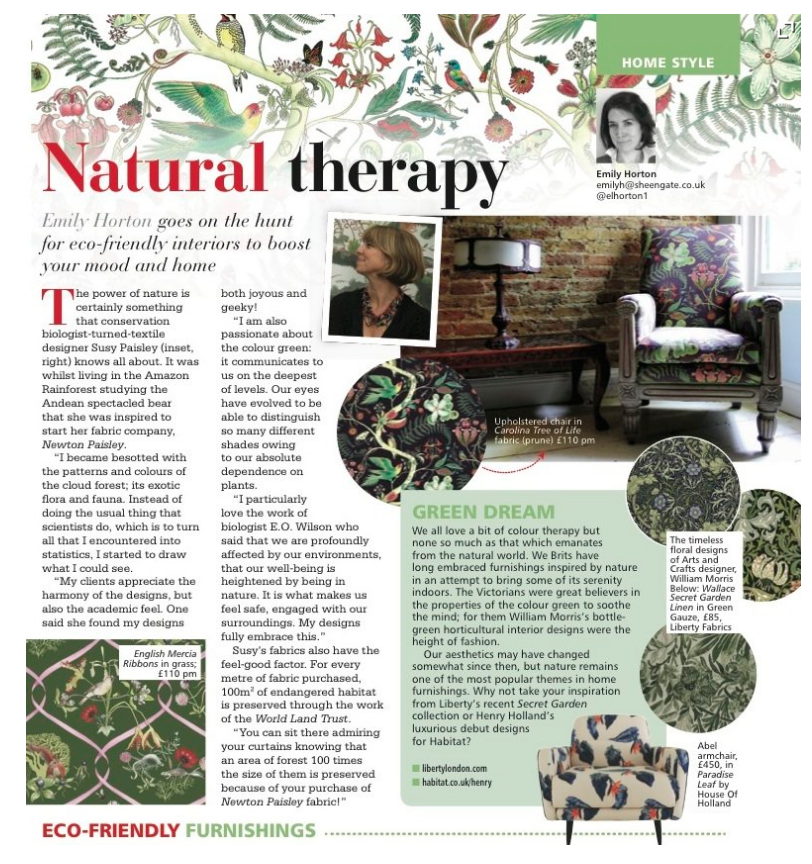
Remembrance Day for Lost Species
Today, November 30th, is the Remembrance Day for Lost Species – a day to commemorate the many species that are disappearing daily.
I have chosen to commemorate the tragic passing into extinction of the last Rabb’s Fringe-Limbed Tree Frog, Ecnomiohyla rabborum. The last member of this species, a male known as ‘Toughie’ died in the Atlanta Botanical Garden on the 26th of September, 2016. The generic name Ecnomiohyla derives from the Greek word ecnomios (“marvelous” or “unusual”) and Hylas, the companion of Hercules.
This was indeed a truly extraordinary species for many reasons. First, this frog could fly. Because of various adaptations, including an extended flat humerus, skin flaps and giant finger pads, this large frog was able to glide as much as 9 metres through the air, steering as it went. Second, it could change colouration almost instantly according to what it landed on in its Panamanian forest home – a process called metachrosis. And third, these frogs practised an extreme form of care for the next generation: the males submerged themselves in water and allowed their tadpole babies to nibble away, exfoliating them, as a way of providing the tadpoles with food.
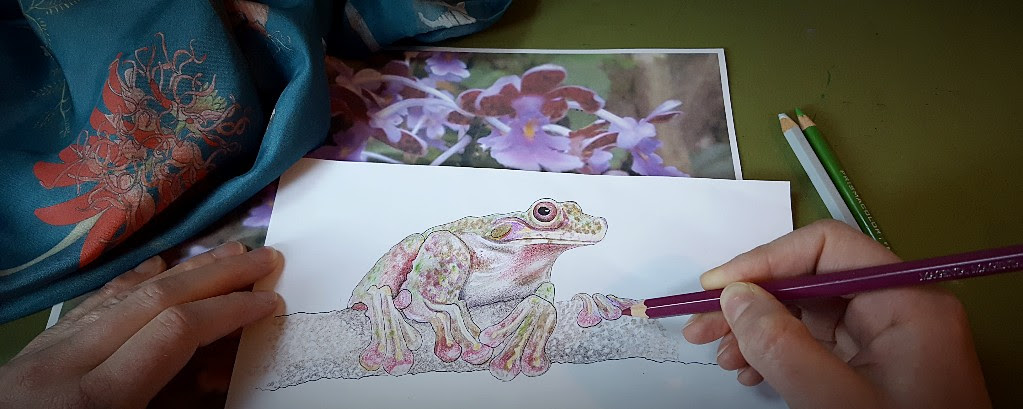
I am creating a print commemorating this incredible frog with a new design to be made into luxurious silk scarves. These will be available at the Last Chance Casino, an event hosted by Synchronicity Earth on March 9, 2017, at One Embankment. If you are interested in attending, please contact them via their website. 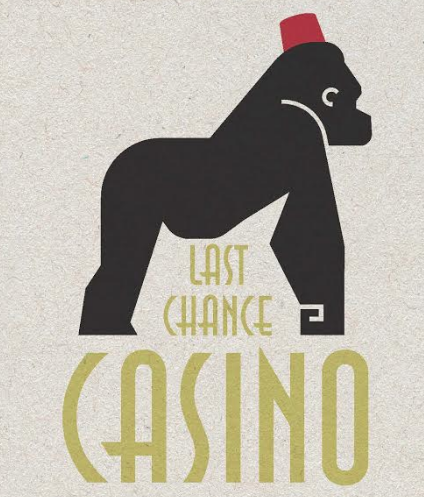
Newton Paisley aims to engage people with the conservation of endangered species and to raise money to support conservation. For every metre of our printed linen that is sold, 100 square metres of critical wild habitat is conserved, through the World Land Trust. We embrace the IUCN Commission on Education and Communication’s message that it is through focussing on ‘Love. Not loss’ that we can turn things around in this extinction crisis.
In that spirit, we love you Rabb’s Fringe Limbed Tree Frog.
Flax fields in Northern France
It is late July and the flax plants that were bright green in the mist and rain of early June have now flowered and gone to seed. Flax is the plant that gives us linen: in Latin flax is called, Linum usitatissimum, or ‘linen that is most useful’. I was lucky to catch the moment that the Flax puller was in action – pulling the flax plants and laying them in tidy lines. The plants are then left to the good offices of the elements (the sun, the dew, and the microbes in the soil), to ‘dew ret’ – separating the long bast fibres from the more easily degradable parts of the stem. These fibres are then ‘scutched’, the step in which the rest of the woody stems are removed, before being spun into thread.
I am completely besotted with everything about linen. I always have been. I am so happy to be dedicating myself to working with this noble, eco-friendly, luxurious and versatile fabric. As well as working with British weavers and printers of linen, I’m also very pleased to able to spend a lot of time in Northern France which is the epicentre of cultivation of this quintessentially European fibre. Four fifths of the world’s production of scutched flax fibers originate in Europe, and France is the world leader.
And talk about sustainability – this crop needs almost no chemical inputs and people have been doing something like this with flax for at least 30,000 years, albeit without the cool Belgian machinery. Spun, dyed and knotted flax fibres were used by European people as early as the Upper Paleolithic. I so like being a part of this ancient industry.
The Amazing John Newton, patron saint of the midlife career change
Amazing Grace was written by John Newton in 1779. My mother’s side of the family – the Newtons – have always liked to claim him as our forebear, although I don’t know of any actual proof. (Nobody in my family ever tries to claim Sir Isaac Newton as a forebear. He’s definitely out of our league.) John Newton was, for at least half of his life, a real bad guy. He spent the first half of his career in the slave trade, as a sailor on and eventually as the captain of slave ships (he was at one time actually a slave himself in Sierra Leone). Then the conversion. “I once was lost, but now I’m found.” He spent the second half of his career as a beloved clergyman and hymnist and fighter for the abolition of the slave trade. His about-face was profound, “It will always be a subject of humiliating reflection to me, that I was once an active instrument in a business at which my heart now shudders.”
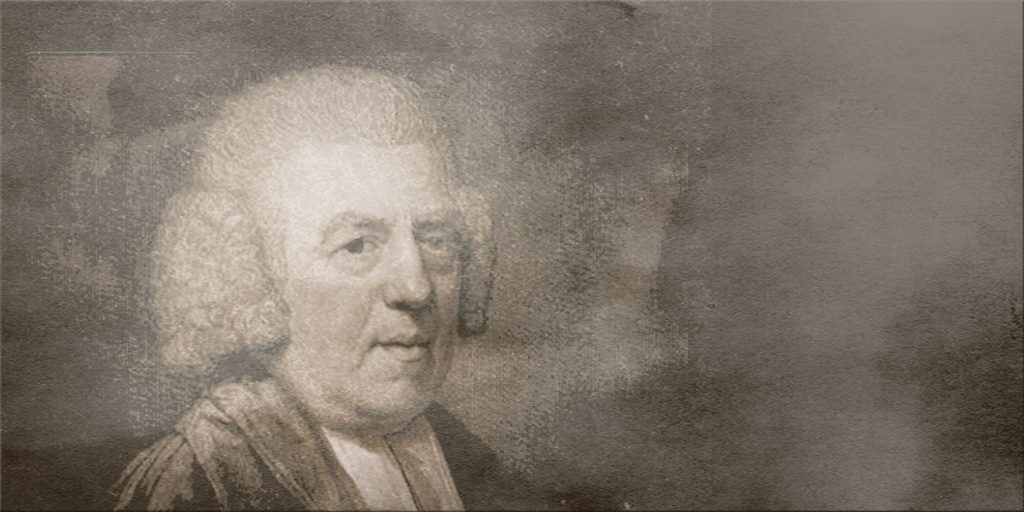
My moving from the academic pursuit of conservation biology to a career in soft furnishings is not quite such a volte face – not quite such a rejection of a path of horrific evil for one of great good. Nor, thankfully, I am not haunted by the ghosts of 20,000 souls, as Albert Finney’s Newton was in the 2006 film Amazing Grace. On the other hand, I am pretty unlikely to leave any great legacy like Newton did. But, as I embark upon this new career, it is gratifying to reflect that the author of this great hymn didn’t begin his career as a clergyman or hymnist until he was 39, and then it was only after applying to the church and being rejected repeatedly for 7 years.
Amazing Grace has always been one of my favourites. It has long been embraced in the USA and always think of it as originating in the American South, even though it was written by a clergyman in Buckinghamshire, England (where, coincidentally I spent my first 6 years). To me, Amazing Grace conveys hope like nothing else – like when President Obama sang this hymn at the euology for Rev. Clementa Pinckney, a victim of the mass shooting at Emanuel Church in Charleston, South Carolina.
